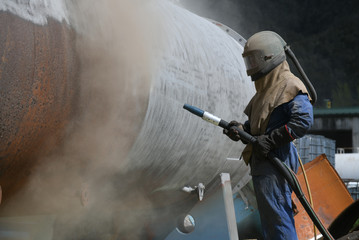In marine maintenance, surface preparation is a critical step that can significantly impact vessels’ longevity and performance. In this dynamic world of marine maintenance, the quest for efficient and environmentally conscious surface preparation methods has led to the emergence of onsite marine soda blasting. This innovative technique employs sodium bicarbonate, commonly known as baking soda, as an abrasive material used to remove coatings, rust, and contaminants from marine structures.

Here, you will be able to explore the profound impact and numerous benefits of onsite marine soda blasting and how it surpasses traditional techniques of grit blasting in Melbourne. So, let’s go for it!
Understanding Onsite Marine Soda Blasting
Sodium bicarbonate, sometimes known as baking soda, is used as a blasting material propelled at high speed during onsite marine soda blasting to remove coatings and pollutants from surfaces. The flexible method can be used on many maritime constructions, including decks, superstructures, and boat hulls. Soda blasting is especially effective for sensitive surfaces because it is mild but effective, without causing damage to the underlying substrate.
Environmental Considerations
Comparing onsite marine soda blasting to conventional abrasive blasting techniques, one of the main benefits is that it is less harmful to the environment. Baking soda is non-toxic and soluble in water, in contrast to more abrasive materials like garnet or crushed glass.
The procedure lessens its ecological impact on marine ecosystems by generating less waste and avoiding introducing toxic materials into the sea.
Surface Restoration and Coating Removal
The capacity of onsite marine soda blasting to effectively eliminate coatings, corrosion, and impurities without sacrificing the integrity of the underlying surface is well known. The method works exceptionally well for recoating surfaces since it leaves a surface clear and ready to accept fresh coats of protective paint.
Soda blasting’s mild abrasive action ensures the original substrate is preserved, minimising the need for significant repairs.
Advantages Of Traditional Blasting Method
1.Environmental Friendliness
The environmental friendliness of onsite marine soda blasting is one of its most prominent benefits. Materials like garnet or crushed glass are frequently used in traditional abrasive blasting techniques, which can harm marine habitats.
Sodium bicarbonate, on the other hand, is a non-toxic and water-soluble material that is used in soda blasting. It is a more environmentally friendly choice because it generates less waste and doesn’t pollute the water.
2.Operator Safety
In any industrial operation, operator safety is of utmost importance. Because of the abrasive material, onsite marine soda blasting is a safer option than traditional procedures. Soda-blasting dust presents less of a health concern when inhaled than silica dust made by conventional abrasives.
This greatly enhances the working environment for operators and lowers the risk of respiratory problems brought on by extended exposure to abrasive particles.
3.Preservation of Substrate Integrity
Although conventional onsite abrasive blasting techniques efficiently eliminate impurities and coatings, they may be excessively forceful and may cause harm to the substrate beneath. Because of its mild abrasive action, onsite marine soda blasting is excellent at maintaining the integrity of fragile surfaces.
This is particularly crucial in the marine industry, where vessels are exposed to corrosive elements. Onsite marine soda blasting minimises substrate degradation, lowering the need for major repairs and overall maintenance costs.
4.Reduce Abrasive Consumption
In addition to providing excellent surface preparation, onsite marine soda blasting saves a great deal of abrasive consumption, demonstrating its dedication to resource efficiency. Marine soda blasting maximises sodium bicarbonate, reducing waste and environmental effects, in contrast to standard abrasive blasting processes that require substantial quantities of abrasive materials.
This decrease in abrasive usage contributes to a greener approach in the maritime industry by aligning with sustainable principles and saving money on marine maintenance operations. Onsite marine soda blasting demonstrates its commitment to achieving optimal results with a minimal environmental footprint by utilising baking soda as a versatile and practical abrasive material. This makes it a preferred option for individuals seeking sustainability and performance in marine surface preparation.
5.Improved Surface Preparation for Coating
Recoating surfaces is made much easier with the help of onsite marine soda blasting. The procedure creates a perfect surface for applying fresh protective layers by eliminating impurities and outdated coatings without affecting the surface profile.
This is an essential benefit for vessels that must be recoated and maintained frequently to prevent corrosion and environmental wear.
6.Versatility in Application
Another significant benefit of onsite marine soda blasting is its adaptability. It can be used on decks, boat hulls, and other marine structures. Soda blasting is more valuable in the marine industry since it can be applied to various surfaces and provides a complete solution for different maintenance requirements.
Whether dealing with delicate surfaces that demand a gentle touch or robust structures that require thorough coating removal, onsite marine soda blasting provides a tailored solution. The process accommodates a range of marine vessels, from leisure boats to commercial ships, showcasing its flexibility in meeting the specific requirements of each application.
7.Cost-efficiency and Long-term Savings
Although the upfront expenses of implementing onsite marine soda blasting can appear similar to conventional techniques, the long-term benefits are evident when considering lower abrasive use, fewer man hours needed for repairs, and longer intervals between maintenance cycles.
8.Regulatory Compliance and Industry Standards
Marine soda blasting done on-site complies with the stricter environmental laws that control marine repair operations. Adherence to these guidelines guarantees the sustainability of maritime activities and bolsters the sector’s standing for conscientious methodologies.
Conclusion
Onsite marine soda blasting is a beacon of innovation in marine surface preparation, combining effectiveness with environmental responsibility. Its impact on preserving substrate integrity, reducing environmental footprint, and contributing to the longevity of marine assets, positions it as a crucial component in the maritime industry’s commitment to sustainable practices.
As vessels continue to navigate the seas, onsite marine soda blasting represents a cleaner, greener approach to maintaining the integrity of these vital assets.
